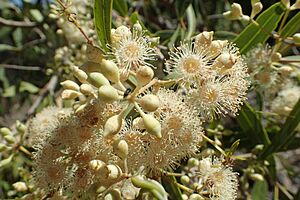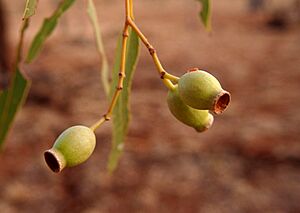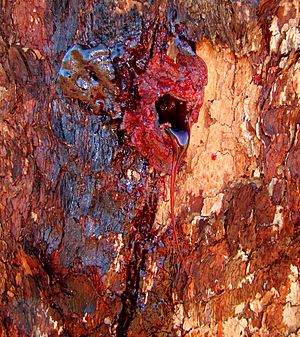Desert bloodwood facts for kids
Quick facts for kids Desert bloodwood |
|
|---|---|
 |
|
| Corymbia opaca in Central Australia | |
| Scientific classification | |
| Genus: |
Corymbia
|
| Species: |
opaca
|
| Synonyms | |
|
|
The desert bloodwood (scientific name: Corymbia opaca) is a special tree found only in northern Australia. It has rough bark on its trunk. Its leaves are shaped like a spear. The flower buds look like clubs, and its fruit is shaped like an urn.
Indigenous Australians, also known as Aboriginal Australians, use different parts of this tree. They use it in their traditional medicine.
Contents
About the Desert Bloodwood Tree
The desert bloodwood is usually a tree. It can grow between 3 and 15 meters (about 10 to 50 feet) tall. It has rough, reddish-brown bark that looks like a puzzle. This bark covers some or all of its trunk.
Leaves, Flowers, and Fruit
Young desert bloodwood plants have egg-shaped leaves. These leaves are about 4 to 9 centimeters (1.5 to 3.5 inches) long. Adult leaves are longer, about 11 to 19 centimeters (4 to 7.5 inches) long. They are green or grayish-green on both sides.
The tree's flower buds grow in groups of seven. Each bud is shaped like a club. The flowers are a creamy white color. After the flowers, the tree produces fruit. The fruit is shaped like an urn and is about 16 to 24 millimeters (0.6 to 0.9 inches) long.
How the Tree Got Its Name
The desert bloodwood was first officially described in 1985. Two scientists, Denis John Carr and Stella Grace Maisie Carr, gave it the name Eucalyptus opaca. They wrote about it in their book.
Later, in 1995, two other scientists, Ken Hill and Lawrie Johnson, changed its name to Corymbia opaca. The word opaca comes from Latin. It means "darkened," "dull," or "not shining."
Where Desert Bloodwood Grows
Corymbia opaca grows in different desert areas of Australia. You can find it in parts of Western Australia, like the Kimberley and Pilbara regions. It also grows in central and southern parts of the Northern Territory, especially near Alice Springs. You can also see it in the Mann and Musgrave Ranges in South Australia.
This tree often grows in sandy soils. It likes areas near rivers or on the lower parts of hills.
Protecting the Desert Bloodwood
Good news! The desert bloodwood tree is not considered to be in danger. The Western Australian Government says it is "not threatened." In South Australia, it is listed as "least concern." This means there are plenty of these trees around.
Traditional Uses of the Tree
The desert bloodwood tree is very important to Aboriginal Australians. They use it for many things, especially for medicine.
Bush Medicine from Sap
Sometimes, a bloodwood tree will lose a piece of bark. This creates a "wound" on the tree. A red, sticky sap, like blood, flows out. This sap is called kino. It flows until it dries and covers the hole.
Aboriginal Australians collect this sticky sap. They use it as bush medicine. They put the fresh sap directly on cuts or sores. It helps to clean the wound and stop germs. If the sap is dry, they can crush it into a powder. Then, they boil the powder in water to make an antiseptic wash.
The sap is also used to treat animal skins. For example, it helps to make kangaroo-skin waterbags strong and waterproof.
Other Uses
People also find "bush coconuts" on the tree. These are not real coconuts. They are galls, which are growths caused by an insect. These bush coconuts are a type of bush tucker (food).
The roots of the bloodwood tree can store water. Aboriginal people would dig up the roots. They would then drain the water into a container to drink. This was very helpful in the dry desert.
See also
 In Spanish: Corymbia terminalis para niños
In Spanish: Corymbia terminalis para niños




